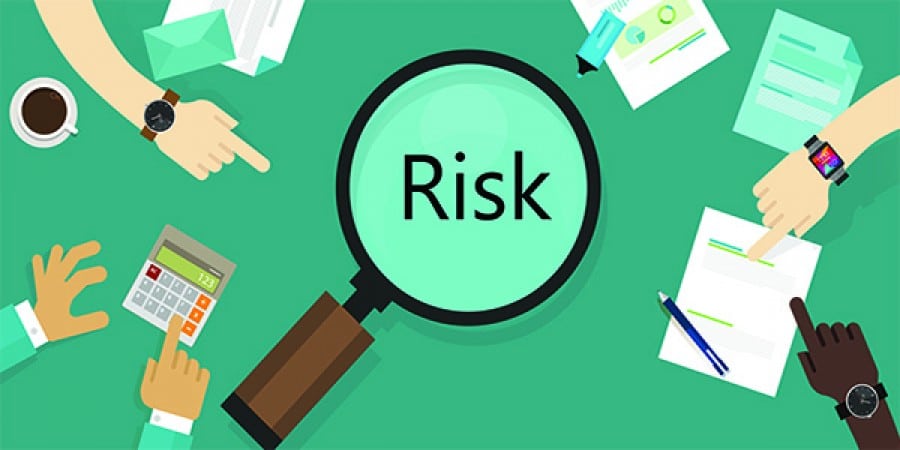Crypto Trading Risk Management Guide
Risk represents the probability of an adverse event occurring to your trades, contrary to your intended outcome. And risk management is a strategy that shrewd traders use to cut down losses. Even though this strategy lies very low on the list of many traders, it can help protect your account from losses. If the risk is managed well, a trader opens themselves up to make money in the cryptocurrency market. Therefore, risk management is an essential skill for anyone who intends to have a successful active trading career. Generating substantial profits is essential when trading, but without the right skills to manage risk, then chances are you could lose it all in just a few bad trades. Let's take a look at some of the crypto trading risk management strategies that you can use in your trading.

In this guide, we will go over various steps you can take to equip yourself with the right risk management skills to help you become a profitable trader over the long run.
But first, let's take a look at some of the types of risks that exist within the cryptocurrency market today:
Legal risk – this type of risk represents the probability of an undesired event happening due to regulatory issues. For example, imagine cryptocurrency trading getting banned in your county of residence, something we have seen happen several times over the years in different countries. In such an incident where the government denies trading virtual coins, platforms, and traders within the country have no option but to comply with the rules.
Market risk – this type of risk is linked to volatility and represents token prices moving either up or down contrary to what you as a trader desires in an open position.
Credit risk – this type of risk is mostly attributed to fraud and theft within the cryptocurrency market. It's likely to arise when the stakeholders behind a platform fail to do their due diligence, thereby leading to breaches like the many hacks we have witnessed within the space leading to huge losses.
Operational risk – this type of risk involves a lack of efficiency within a platform. For instance, when, as a trader, you are unable to deposit, trade, or even withdraw money into your wallet.
Liquidity risk – this type of risk arises when, as a trader, you cannot convert your entire position to fiat currencies like Euro or USD, which can be used in everyday spending.
Crypto Trading Risk Management Strategies
When it comes to trading like any other venture, the battle is won before it's ever fought. What this means is that planning is vital if you are going to execute a plan to perfection. This is why successful traders live by the phrase “plan the trade and then trade the plan.”
With this in mind, there are several crypto trading risk management strategies to keep in mind as you embark on your trading journey. The first thing is ensuring your broker is available to facilitate frequent trading since there are brokers that cater to clients that trade infrequently. These brokers charge active traders high commissions and don't offer the right analytical tools.
Another thing you should know about is setting stop-losses(S/L) and take-profit (T/P) targets before executing a trade. To be a successful trader, you need to be aware of the price that you are willing to buy and the price that you are willing to sell. This will help you measure the resulting returns against the probability of the asset hitting the desired targets. If the adjusted return is high enough, then you can execute the trade.
On the other hand, unsuccessful traders enter trades without knowing what points to take profit or set a stop loss. This leads to erratic behavior as emotions take over and dictate their trades. The problem for such individuals who don't plan is that profits can entice them to hold on for even more gains, and when in a losing trade, they may hold on longer in hopes that things will turn around, which could be disastrous.
With that in mind, let's go over a few key crypto trading risk management strategies that can help you as a trader:
Position Sizing
Don't Risk More Than 1% of Your Trading Account
This rule suggests that you should never risk more than 1% of your trading account on any given trade. It's meant to keep you in the game for the long run. Even if you get unlucky and lose like 30 trades in a row, you will still have 70% of your initial trading balance. Given that you will be doing all the right things before placing your trades, the likelihood of losing 30 in a row could be quite rare, but even if it was to happen, these small setbacks could quickly be recovered through a few profitable trades.
Thanks to compounding power, during your losing streak, the risk on each trade will continually grow smaller due to reverse compounding. The vice versa is true.
That is the extraordinary thing about risking a fixed percentage of your trading balance on each trade. You will experience the power of compounding on the way up, which means making more, and if things don't go well, you will experience reverse compounding on the way down, meaning you will be losing less with each failed trade.
MYC Trading Course
Crypto trading risk management strategies are also explored in the MYC Trading Course. A crypto trading course designed to give you the skills to start making money trading cryptocurrency. In addition to this, the course offers benefits such as:
- How to start with $100 and make consistent profits.
- How to read and analyse a cryptocurrency candlestick chart.
- Trading strategies for predicting market movements, with real world examples.
With over 20,000+ students, the MYC Trading Course is giving thousands of people the skills to make money trading cryptocurrency. To get started, head over to our course page by clicking this link: MYC Trading Course.
Calculate The Risk/Reward Ratio
You must understand the risk/reward ratio before entering any trade, otherwise, this will lead to risky trades that will lose you money. The ratio indicates the return you are to expect from a given trade compared to the risk undertaken. So, the lower the ratio, the more risk is involved in the trade.
The formula for calculating risk/reward ratio is
(Target – entry)/(entry – stop loss)
To save time, you can use the Long Position or Short Position tools in the trading view to calculate the ratio. However, there is a rule of thumb when it comes to risk/reward ratio;
- If it's lower than 1:1 never place a trade
- 1:1 is ok to trade
- 1:2 is great to trade
- 1:3 and higher is the ideal ratio to trade.
Let's use the below trade as an example to aid us with various calculations;
- Trading pair: ETH/USD
- Direction: long
- Entry Price: $220
- Target Price: $300
- Initial stop loss: $205
- Risk/Reward: 1:5.33
- Risk Per Trade: 1%
Know How Much You Are Risking
It's essential to calculate how much you can afford to lose with each trade comfortably. Therefore, if your account size is $10,000 and you apply the 1% rule, you can not afford to lose more than $100 per trade.
You can use the below formula to calculate the maximum risk you can bear:
Account size / 100 = Your maximum $ risk
You should understand that this doesn't mean the position you enter the trade has to be at $100. Instead, it means your position size should be such that if you hit the stop loss, you will only lose $100.
Using the above trade, the account size is $10,000, which means you can risk $10,000/100 = $100 per trade.
If you enter the trade at $220 and the price declines to $205 where your stop loss is set, to be able to calculate your position size effectively, you must calculate your maximum pip risk.
Pip means price movement; therefore, if the price moves from 150 to 151, the pip is 1.
Maximum pip risk = Entry price – Stop loss price
$220 – $205 = $15
Using our trade as an example, the maximum pips you can lose is 15. When the trade hits the stop loss, you will lose 15 pips. Remember, you choose to risk $100 on the trade. Therefore, this trade should be sized in a manner where each pip is worth $6.66.
Pip value required for trade = dollar risk / Pip risk
$100/15 = $6.66 per pip
Thus, if you correctly chose a trade size that exposes you to only a $6.66 risk per pip, then you are likely to take a loss of only $100 or 1% of your $10,000 in your account.
Below is a formula for how you can calculate your position size:
((size of your stack * risk % per trade) / (entry price – stop loss)) * entry price.
Using the trade example above:
(($10000*0.01)/ ($220-$205)) *$220 = $1467
It may surprise you that a $1467 position from the $10,000 is almost $15% of the entire stack. However, when you hit the stop loss, you will lose 1% ($100) of your stack.
We can prove this below:
$205/$220 = 0.9318
0.9318 * $1466 = $1367
$1467 – $1367 = $100
How to Set Stop Loss and Take Profit Targets
A stop loss point is a price target that tells you when to sell an asset and take a loss on the trade. It's used when the trade doesn't go as planned. The point is crucial to prevent the “it will come back” mentality, thereby minimizing losses before they grow larger. For example, if an asset breaks below a key support level, most traders will sell as soon as possible.
In contrast, a take profit target tells you when to sell your asset and take profit on the trade. Here, you try to limit the additional upside given the likely risks. For example, if an asset is nearing a key resistance level after a massive upward movement, you may want to sell your coins before a consolidation period occurs.
Setting Stop Loss Targets Effectively
The setting of both stop loss and take profit targets is typically done using technical analysis. However, fundamental analysis can also play a vital role in timing. Think of a situation where you are holding an asset before some good news on the asset hits the market, and there is excitement building around the asset. You may consider selling before the news hits the market if you sense expectations have become too high. This is regardless of whether your take profit target has been hit or not.
One of the most popular ways of setting these targets is using moving averages. They are easy to calculate and are widely tracked by the market. Some key moving averages include the 50, 100, and 200 – day averages. You can set them by applying them to the asset's chart and determining whether the asset price has reacted to them before either as a support or resistance level.
Also, you can use support and resistance trend lines to set take profit and stop loss targets. This is done by drawing previous highs or lows that may have occurred on notable price points. Just like it's the case with moving averages, you aim to determine key levels where the price reacts to trend lines.
What to Consider When Setting Targets
You can use long term moving averages since crypto assets are volatile. This will help reduce the chances of a stop loss order being triggered thanks to a meaningless price swing.
Ensure you adjust your moving averages to match the target price ranges. So, more extended targets should employ broader moving averages, thus reducing the number of signals generated.
Always adjust the stop loss according to the market's volatility.
Crypto Trading Risk Management Strategies You Can Embrace
Accept when you fail – when it comes to trading, risk is always apart of it, and since we can not eliminate risk, we can only manage it, it's good to accept your losses and move onto the next trade.
Measure the drawdown – drawdown refers to the reduction of your account size from a series of losses. For example, if you lost $1,000 from $10,000, your drawdown is 10%. The bigger the percentage, the more you need to put into the next series of trades to recover your losses. Therefore, it's vital to always limit the number of trades you have running simultaneously depending on your account size and still adhere to the 1% rule.
Focus on your win rate – since you can't win them all, be ok with winning most of them. By focusing on your wins, you will develop a positive attitude as a trader.
Consider the fees involved – part of your risk management plan should involve consideration for the fees involved in trading like withdrawal fees, leverage fees, and so on.
Conclusion
To win any life battle, planning is vital. Some people have made a fortune through trading, especially in the crypto market. These people are not always the smartest, but what they possess is the right skill set that allows them to flourish. Therefore, if you want to succeed and make money trading, educating yourself on the best crypto trading risk management strategies is critical. Remember, never risk more than 1% of your capital, always assess your risk/reward ratio, and, most importantly, use stop losses.




